DISCLOSURE: If I link to relevant products or helpful info it may be an affiliate link, meaning I may earn a small commission. As an Amazon Associate & other affiliate, I earn from qualifying purchases at no extra charge to you. The views & opinions are my own. Please see the disclaimer and privacy policy.
Last Updated on April 4, 2024
Recipes for Foods from Around the World
What should you do when you can’t travel and are STUCK IN YOUR HOUSE?
Cook some awesome foods from around the world to take your taste buds on a trip of a lifetime without going out of your own kitchen! Let’s go around the world without traveling!

Try these 16 easy recipes from around the world, submitted by bloggers that want you to also enjoy the feast. Prepare the dishes and let the aromas whisk you away to far-off destinations. Which country would you like to visit first? There are submissions from Europe to Asia to Africa and even beautiful places in between.
These traditional foods from foreign countries will delight you and introduce you to gastronomy, the study of food and culture. Make these easy recipes in your own kitchen and enjoy the aromas filling your house when you can’t travel. The submissions were obtained from bloggers all around the globe and they explain how their traditional foods will satisfy your wanderlust and take you on vacation to another destination.
Easy to make Recipes from Around the World
Sicily: Arancini
Michelle from Moyer Memoirs

As you travel across the globe from home and indulge in gastronomical delights by cooking easy-to-make foods from around the world, make a stop south of Italy at the island region of Sicily. Arancini originated in Sicily many centuries ago and nowadays you can find these rice balls on any street and any market throughout the country, although made a little bit different depending on the region.
These little rice balls are also called aracina in Palermo and other parts of Sicily. They are stuffed with vegetables, cheeses and sometimes meats and then fried to a golden brown in olive oil. When you are making your own Arancini, you can choose your own filling to make the perfect dish.
You can travel to Sicily from your own kitchen by making these delicious rice balls, playing some Sicilian music in the background, pouring yourself a glass of wine and sitting back to take it all it. The recipe is quite easy, but a little bit time consuming –so perfect for when you are stuck at home, can’t travel and need to satisfy your Wanderlust! We made Homemade Arancini for the first time and even compiled a video for you to follow along with the recipe.
Get step-by-step ARANCINI RECIPE INSTRUCTIONS HERE.
Wondering what other street foods are popular in Palermo, the capital, and throughout Sicily? Take a virtual stroll through the market after you visit all the historic sites as you read about our day tour in Palermo.
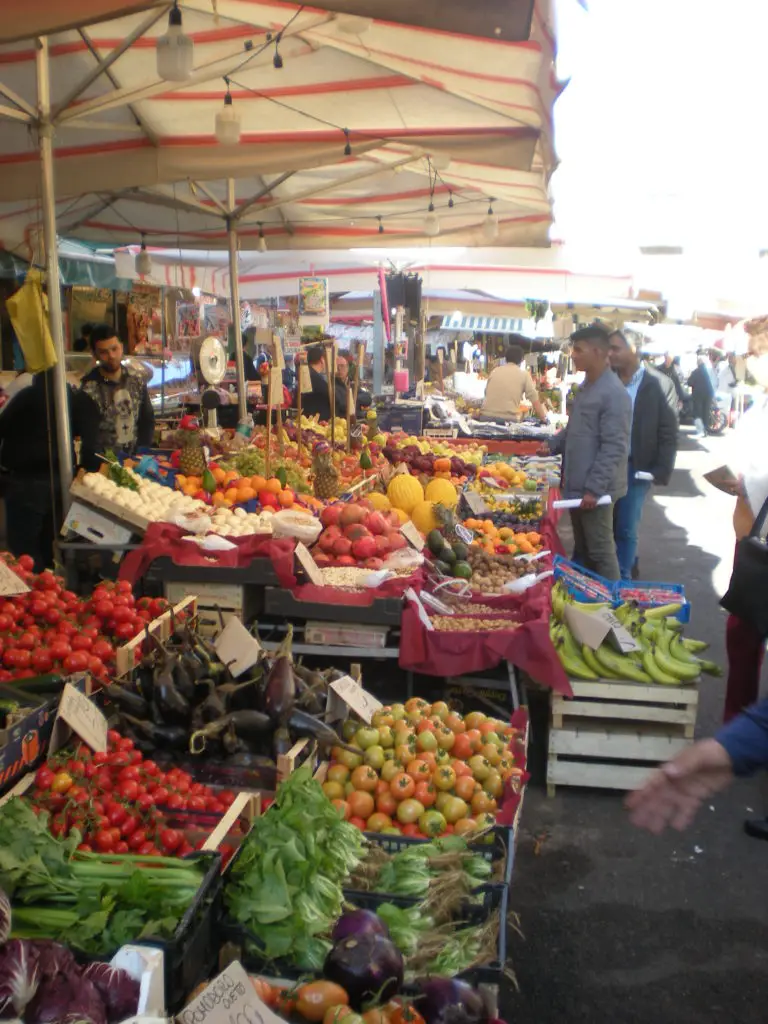
Italy: Caprese-inspired pizza
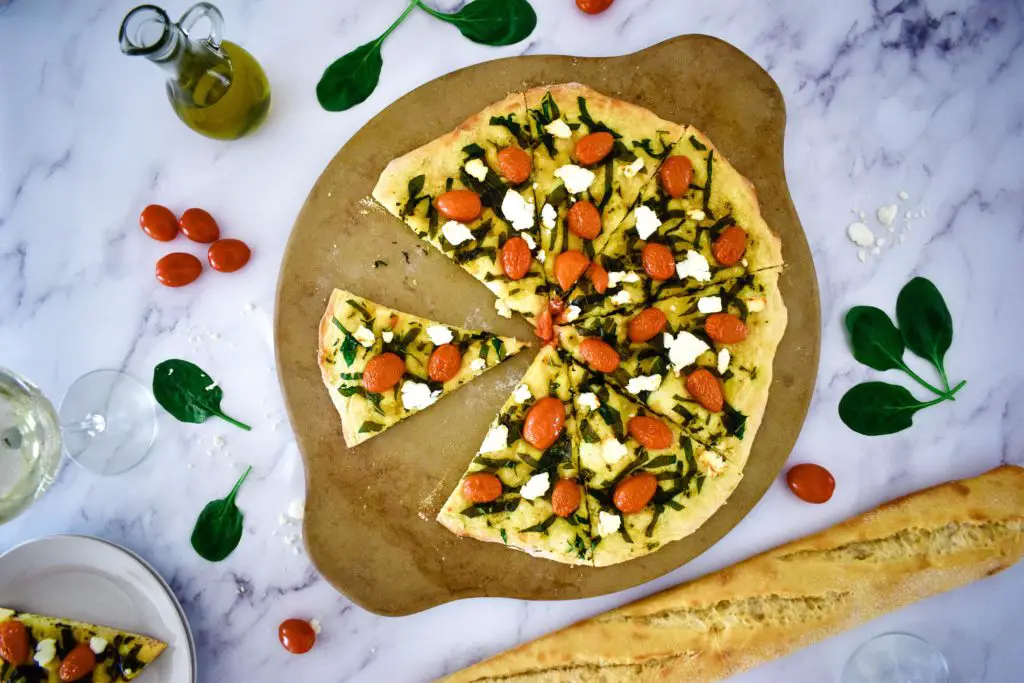
Caprese is an Italian salad that has been gaining popularity in many parts of the world! In the States, many restaurants offer caprese-inspired food, but very few people realize that caprese is a salad consisting entirely of tomatoes, mozzarella cheese, basil leaves, and an olive oil-based sauce. For many people, that doesn’t sound the most appetizing on its own, which is why we often put these ingredients in sandwiches or on pizza.
If you’d like to envision yourself sitting outside a quaint Italian eatery, watching locals pass by, and eating a traditional Italian dish, then this caprese-inspired pizza will be a great option for dinner. You can use either mozzarella cheese or goat cheese depending on your flavor preferences. Although the final product looks elegant, it’s very simple to make!
It is fun to make with the other people in your house if you’re looking for a fun activity. While it may not be the most authentic Italian dish, its taste will be a hit for everybody–even if they don’t necessarily like tomatoes. Since pizza has Italian origins, this is like you’re combining two of Italy’s popular foods into one meal. Even if you’ve never been to Italy, you can imagine yourself as an Italian chef from a movie while you make this delicious pizza which will certainly become a new favorite!
Wales: Welsh Rarebit
Kacie from therarewelshbit
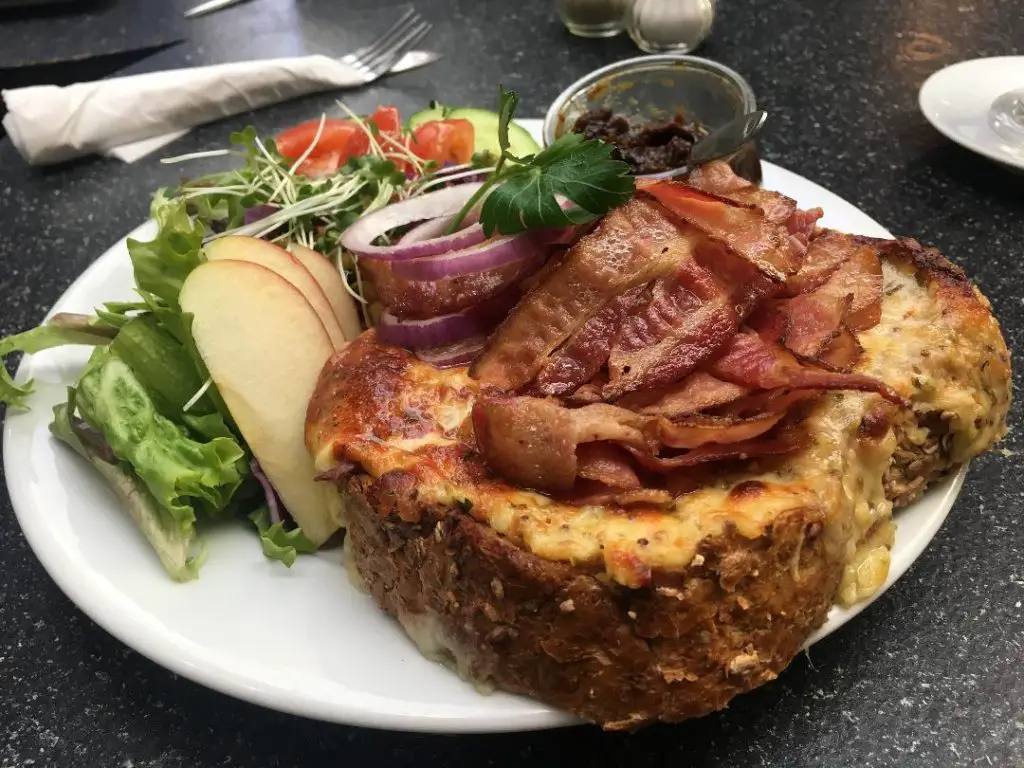
Often likened to glorified cheese and toast, Welsh rarebit is one of the most popular Welsh comfort foods of all-time. However, there’s actually a little more to this quintessential Welsh dish than meets the eye. Made using beer, ale, or stout mixed with flour, cheese, mustard, and butter to form a gooey mixture which is spread onto lightly toasted bread and grilled, Welsh rarebit is a fine example of the cheap, staple foods eaten by the Welsh working class in years gone by.
In fact, many believe that Welsh rarebit (originally known as ‘Welsh rabbit’) gets its name from the fact that many working-class families often couldn’t afford to eat rabbit or other meats, so they’d substitute with other ingredients instead.
Ready in just 10 minutes, Welsh rarebit couldn’t be easier to prepare for yourself at home. If you like, you can add your own unique twist; some people like to add an egg for a ‘Buck Rarebit’, while others like to add a few rashers of crispy smoked bacon.
Try Kacie’s ULTIMATE WELSH RAREBIT RECIPE – and learn everything you ever wanted to know about this wonderful Welsh dish and then pop over to Instagram for other delicious travel foods.
France: Crepes
Stephanie from Parisian Abroad
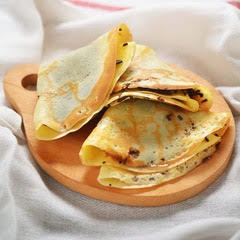
The dish I chose to represent France is my mom’s crepes recipe. It is an easy and quick recipe but oh so delicious! Personally, it reminds me of going to a region in France called Britain (origin of crepes) and trying numerous “creperies” but always thinking that none of those would compare to hers! A sentimental attachment for sure.
Eating crepes will make you feel like you’re in France without even being there because there is a special way the French make them. If you’ve visited France and tried a crepe, you know what I’m talking about! There is a reason crepes are famous around the world and I believe it is because it’s associated with the culinary talent and amazing food variety in France. Crepes also have that great taste and reputation because often, they are associated with happy family moments like “Mardi Gras” where everyone gathers and eats… yep you guessed it… crepes!
The good thing about this dish is that you can have it salty or sweet! For a traditionally salty French crepe; put some Emmental cheese, potatoes, and fresh ham. My favorite sweet one is obviously Nutella! So good you won’t be able to stop. While you prepare this gorgeous dish, put on some French music and enjoy the delicious smell of the mix!
Portugal: Serradura Dessert
Rosemary from Authentic Food Quest

Food allows us to take a journey to a cuisine and culture. Regardless of the external circumstances or whether it is possible to travel, a simple trip to your kitchen can bring the world to you.
Portugal, a country we fell in love with has a rich and diverse gastronomy. The food is simple and impeccably prepared.
One of the tastiest sweets we came across is a homemade dessert known as Serradura. The name serradura is Portuguese for “sawdust”, and it comes from crushed Maria cookies or biscuits which resemble sawdust.
This popular dessert is incredibly easy to make. It is a no-bake dessert that can be easily assembled in twenty minutes or less.
To make this delightful Portuguese dessert, you only need four ingredients. Maria biscuits, which are a Portuguese favorite, condensed milk, whipped cream, and vanilla extract.
After you crush up the Maria biscuits, simply layer crushed biscuits and sweetened cream until you have a stacked dessert.
Refrigerate for a couple of hours (overnight is better) and savor Portugal with family or guests.
Find Rosemary’s recipe for PORTUGUESE SERRADURA DESSERT on her blog and follow her travels on Instagram.
Cocktails Around the World
Before we travel any further with our main dishes…….STOP!
Relax and make some COCKTAILS FROM AROUND THE WORLD! Travel to different countries while you sip and sample these delicious cocktail recipes.
After Cocktail Hour is over, we will resume our main dish travels with the island of Jamaica!

Jamaica: Ackee and Saltfish
Kim from PHraseD

Gorgeous beaches, where the water is so clear you can see the bottom, majestic mountains that tower in the distance and breathtaking experiences, like swimming with dolphins and fjording the Rio Grande. Jamaica is without a doubt the answer to a traveler’s wanderlust.
Unfortunately, right now, we can’t physically satisfy that wanderlust, but I can help to bring Jamaica to you in the form of our national dish. Ackee and Saltfish is the Jamaican national dish and is a favorite with locals and tourists. Not only is it delicious, but it also can be eaten at any time of day, with a large variety of items. Ackee can be eaten for breakfast, lunch or dinner with bread or rice. Jamaicans eat it with hard dough bread, rice, breadfruit, dumpling (fried or boiled) and boiled green banana, yam, potato, and the list goes on.
Let’s get ready to go to Jamaica through food. Many grocery stores have an international aisle and I’ve been pleased to notice that they carry canned ackee. Grab a can or two. While you’re shopping, grab a pack of bacon, a small onion, 2 cloves of garlic, a small tomato and a green or red bell pepper. Saltfish is hard to come by, outside of specialty grocery stores, but to prepare ackee, you can substitute a salty type of meat. In a pinch, bacon or precooked chicken will do.
Chop the onion, garlic, tomato, bell pepper, and bacon into bite-sized chunks. Then, in a skillet, pour about 1-2 tbsp of oil, depending on the type of bacon used. Sautee these ingredients together until the bacon is almost cooked and the onion is translucent. Then, drain the liquid from your canned ackee and add the ackees to the skillet. Stir gently, cover and reduce to low heat, for a few minutes, until the ackee is heated through and the bacon is fully cooked.
As you enjoy this traditional Jamaican dish, feel the breeze and the spray of the ocean as you are transported to one of the world’s most gorgeous beach destinations. Want to keep your Jamaican vacation going? Try this recipe for JamaicanBanana Fritters, which can be made from 5 items in your kitchen now.
Walk good (A Jamaican expression wishing travelers a good trip as they depart)!
Need more? Read Kim’s I am an Island Girl to learn what life was like growing up in Jamaica.
If you are enjoying these foods from around the world, take a look at how you can also enjoy SNACKS FROM AROUND THE WORLD.

Mexico: Elote Corn
Allison from Crockpotsandflipflops

Take a stroll through the busy streets of Mexico City and you will smell the sizzling corn on the cob being sold in carts all along the road. This is how this special corn got its name, Mexican Street Corn. Mexican Street Corn is served with butter, salt, chili powder, mayonnaise, lime juice and cojita cheese.
Mexican Street Corn goes by another name as well, Elote. In Central America and Mexico corn, on or off the cob is called, Elote. This name is derived from the Nahuatl elotitutl, meaning tender cob. As you walk the street the Eloteros, set up stands, luring in hungry people walking by with their delicious cobs kept warm on rotating open fire grills. After tasting this amazing corn you will immediately be hooked and may not be able to go back to eating it with just butter and salt again.
Once I had tried this delicious corn I had to make it once I returned home. Nothing can compare to having the ambiance of the streets of Mexico City but I wanted to share this recipe at our next party. I always try to make things simple for parties so I can enjoy my friends’ company. Also, I find that sometimes people don’t really enjoy eating an entire corn on the cob at a party so I thought making it in the slow cooker would work best so everyone could eat it as a dip or with their dinner. There was none left by the time we had dinner but everyone loved the unique flavors and taste. Now you can have this little taste of Mexico City street food at home too.
Try out Allison’s amazing ELOTE CORN RECIPE for a party or just as a side to go with tacos! Follow Allison on Instagram for more delicious recipes!
If you are just looking for a Mexican side dish to go with your meal, try Lupe Tortilla’s Charro Beans. It goes well with any Mexican main course, or any time you want a hearty side dish that is full of beans
Peru: Ceviche
Donna from Explore the Road with Donna Marie
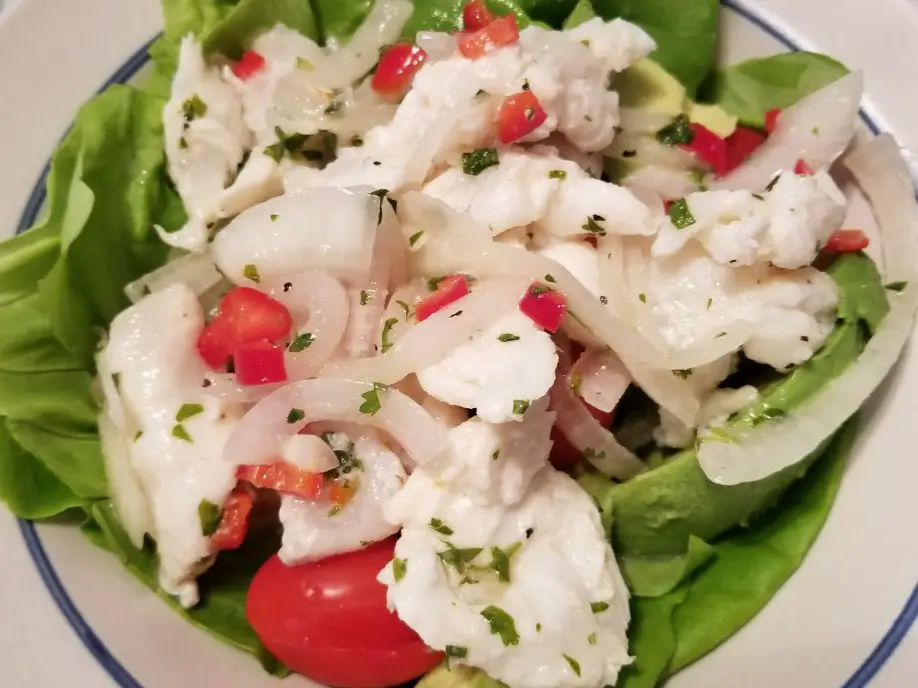
Peru is South America’s third-largest country with a variety of climates. There is the mountain region of the Andean Highlands, the jungle region of the Amazon rainforest, and the coastal region. With an abundance of seafood to be found in the coastal region, it is no wonder ceviche is such a popular Peruvian dish.
Ceviche is a fish dish found in many Latin American and South American countries. However, each country has its own special way of making it. Ceviche isn’t cooked with heat. This sometimes turns people off, thinking they are eating raw fish. However, the fish is cured by using citrus juices. The acid in the citrus juices turns the fish opaque, just as if it was cooked with heat.
Ceviche is made with firm white fish such as halibut, tilapia, sea bass, or mahi-mahi. Then it is mixed with lime juice, onions, cilantro, and jalapenos. Don’t expect to eat this right away. It needs to be cured overnight.
I love the tangy citrus flavor of ceviche. It is great to eat in warm weather since it is served cold. This tasty dish can be eaten as an appetizer or as a meal accompanied by sweet potatoes or corn on the cob. I like to serve it on a bed of lettuce.
Since the ingredients for ceviche are readily available in grocery stores, it is easy to make at home. Try this recipe and other CEVICHE RECIPES when you want to capture the traditional taste of Peru.
Explore more Must-try Foods from Peru.
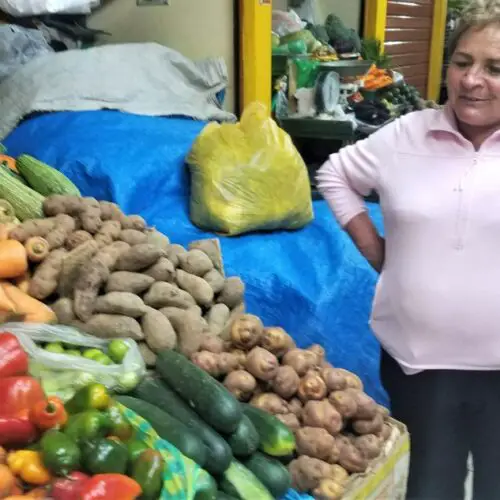
New Zealand: Corn Fritters
Katie from The World on My Necklace

New Zealand doesn’t really have a distinctive cuisine, our food identity has mostly been influenced by the United Kingdom, but there are a few dishes that are truly Kiwi, and along with bacon and egg pie and pavlova, one of the most well known New Zealand dishes is the humble corn fritter.
I’m not sure about the background of corn fritters in New Zealand and how they became such an ingrained part of the cultural landscape here. All I know is that corn fritters have been a popular Kiwi dish for many years, and are usually eaten at brunch, with poached eggs and smoked salmon or bacon.
After making a smooth batter by beating eggs with self-raising flour and seasonings, all you need to do is add some grated cheese, corn, and a few other vegetables, before frying in oil for a few minutes on each side.
They are simple to make, the ingredients are inexpensive and easy to find, it is a flexible recipe that you can change to your taste, and most importantly – they are delicious.
Corn fritters are a good representation of New Zealand as a whole because they are unpretentious and easy-going, and that is what New Zealanders – Kiwis – pride themselves on being. Down to earth and un-intimidating. And I’m sure corn fritters will live on in New Zealand for years to come.
To make this cuisine when you can’t travel, find Katie’s CORN FRITTER RECIPE on her blog and follow along with her travels on Facebook.
Germany: Rouladen
Linda from allaboutbaby
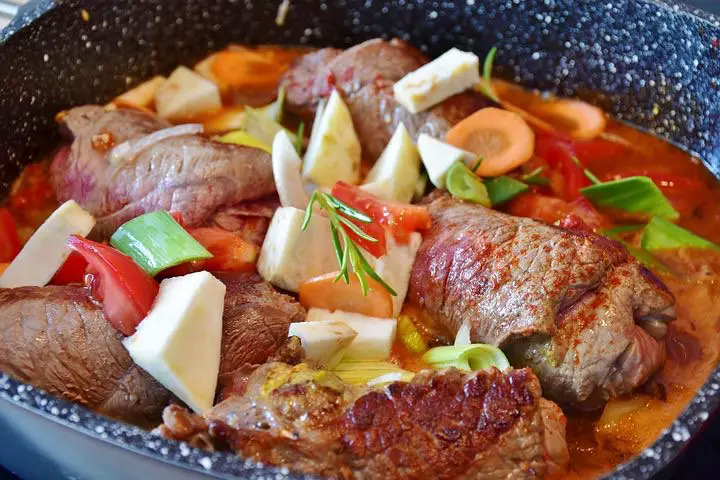
Rouladen or Roulades are a typical German dish that you can find anywhere across the country. Depending on the area this delicious meat roll is filled with different ingredients but no matter how you make it the outcome will be absolutely delicious and sure to bring you some compliments.
When looking for a specialized menu, Germany is full of many delicious dishes. Hamburg has a lot of good options for vegan restaurants.
Find Linda’s RECIPE FOR ROULANDEN on her blog and follow her on Instagram.
India: Mutton Balls
Jay from Madras Recipes
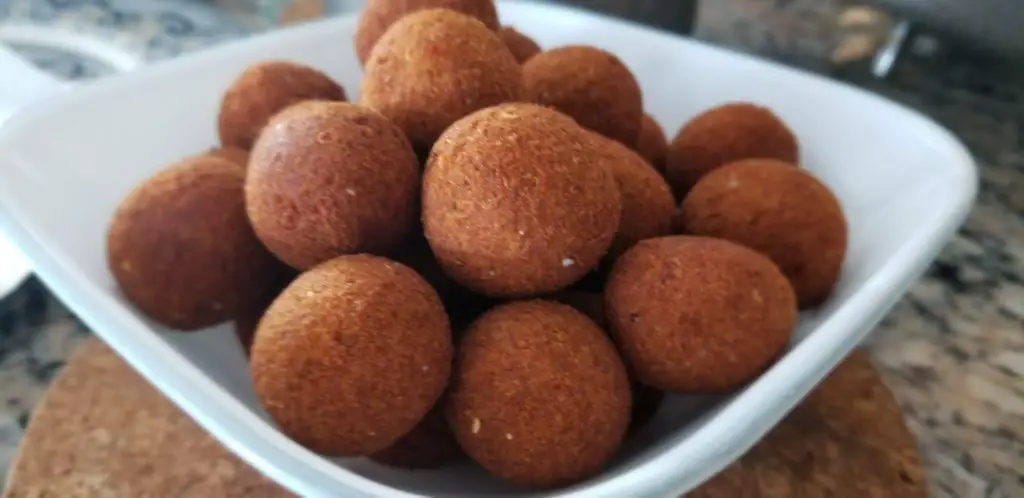
Mutton Kola Urundai|Mutton Balls are deep-fried minced mutton balls made with beautifully spiced masala. This is a very simple recipe. It can be served as both an appetizer and as a side-dish. Kola urundai has a unique texture, it is very crispy on the outside, and soft and flavorful on the inside. This is a famous dish from the temple district Thanjavur, Tamil Nadu, a South-Indian state. The Mutton Kola Urundai|Mutton Balls recipe has been in my family for many generations and my family hails from Thanjavur.
Thanjavur is known for the famous Brihadeeswara Temple, which was built by the King Raja Raja Cholan in 1010 AD and it is also a UNESCO World Heritage Site. After a thousand years, the temple still stands proud and majestic. The temple is a major pilgrim and tourist attraction in South-India. The famous River Cauvery also flows through this district, hence agriculture is a major occupation of the people in and around this district. Thanjavur is famously called the Rice Bowl of Tamil Nadu state. The people of Thanjavur are well known for their hospitality. If you are a guest to one of our homes, you will be treated and pampered like a king. So here is a dish, Mutton Kola Urundai|Mutton Balls, that is always served when we have family/friends visiting us. My mom still remembers her grandmother making this dish. She tells me that her grandmother made mutton balls that were nearly the size of tennis balls!!
There are many variations of this Mutton Kola Urundai|Mutton Balls recipe, based on which district of Tamil Nadu you are from. The main difference between the recipes is the various whole spices used to make the mutton balls. You need minced mutton, fennel seeds, poppy seeds, red chilis, grated coconut, split bengal gram, curry leaves, roasted bengal gram, salt, and turmeric powder. Roast the mutton, and the spices; grind it with the onions and coconut to a smooth paste; gently roll them to make balls (any size), and deep fry them. It can be served with any curry/gravy along with steamed white rice. Hope you will remember Thanjavur people and their hospitality whenever you make this dish!
Take a look at the details for Jay’s recipe for Mutton Kola Urundai/ Mutton Balls and follow Jay on Facebook for more flavorful recipes and stories of India.
Malaysia: Rendang Chicken
Sienny from SiennyLovesDrawing

While unable to travel even around my own home country ~ Malaysia, I actually craved for Rendang Chicken during the Movement Control Order (MCO) period, unsure of the reason. Though I’m not a spicy foodie, however, I love foods with spices & thick gravy. Lol…Ha…Ha…
Rendang chicken is a spicy stewed dish that originated from Minangkabau, Indonesia. Specifically, this is a specialty of Batusangkar & Bukittinggi, Indonesia. Rendang is not just cooked with chicken, it can be with beef (Rendang Beef), or lamb (Rendang Lamb).
In Malaysia, rendang dishes are traditionally served among the Malay community. So, whenever you’re traveling across the different states around Malaysia, rendang dishes can be easily spotted at either roadside stalls, cafes or restaurants as well as a famous home cooking dish for the Malay, actually non-Malay too. You can enjoy the rendang dish with steamed rice, noodles or bread. Hmm…The rendang cooking styles, ingredients & tastes may be different from state to state within Malaysia. That’s the unique culture of Malaysians
Do enjoy the cooking vlog captured from my mum’s home cooking of chicken rendang during MCO to ease my craving, yeah!! It’s now much easier to prepare rendang dishes with ready-to-cook sauces in the market. In this vlog, my mum was using the Gillies Rendang. The sauce ingredients are Split Gill Mushroom, Coconut Milk, Onion, Oil, Sugar, Garlic, Coconut Paste, Lemongrass, Ginger, Galangal, Dried Chili, Salt, Turmeric Leaves, Lime Leaves and Spices
Follow Sienny on Instagram and whenever you’re traveling to Malaysia, do remember to taste a rendang dish during your trip
Japan: Kaiseki
Kavita from Kavey Eats

Japan is a dream destination for food lovers, with many wonderful dishes to explore and enjoy. Some are familiar globally, such as ramen, sushi, tempura, and teppanyaki. Others, you might have read about and be keen to try – okonomiyaki, tonkatsu, udon, and soba noodles, to name just a few.
But one experience you must seek out in Japan is a traditional kaiseki meal. It’s more of a multi-course feast than a single dish and is a great way of trying local and seasonal specialties in a traditional setting.
Born of the small dishes once served during a tea ceremony, kaiseki is most commonly found in traditional Japanese inns. You can also enjoy it in dedicated specialist restaurants in cities like Tokyo and Kyoto.
Kaiseki meals have a certain formula that they follow in terms of the dishes and the order in which they are served, but there is plenty of room for variation and inventiveness. You will usually be served some or all of the following: a selection of appetizers, sushi or sashimi on ice, a stew of seafood or meat with vegetables, grilled fish or meat, deep-fried items such as tempura, steamed items, rice, miso soup, and at least one pickle. To finish, it’s usually fresh fruit or traditional sweets.
Everything is beautifully presented, and delicious.
Mauritius: Dholl Puri
Pavani from Cook’s Hideout

I personally think street food represents the best of any country. Of course, there are recipes that are passed down through generations, but they are mostly enjoyed by locals. Street food on the other hand is enjoyed by everyone – natives and tourists alike. So, I make it a point to try what everyone eats in every country I visit.
Today, I have a delicious street food dish from Mauritius, which is an African island nation in the Indian Ocean. Its cuisine is widely influenced by Creole, French, Chinese and Indian cuisines. There are also quite a few dishes that are unique to the island.
In the 19th century, many Indian workers migrated to Mauritius and brought their dishes with them. Traces of both north and South Indian culinary traditions are seen in Mauritius. The dishes have evolved over the years with the inclusion of Mauritian flavors and have changed quite significantly from the original.
‘Dholl Puri’ is a lentil stuffed flatbread that is usually served warm wrapped around a variety of curries and pickled vegetables and chutneys. It is a beloved street food in Mauritius, that is quite easy to make at home.
This dish is based on Indian parathas or stuffed flatbreads that were introduced to Mauritius by Indian workers more than a hundred years ago. But the fillings and the way it is served is uniquely Mauritian. They are typically served and sold in pairs wrapped in paper to take away along with a soft drink.
The RECIPE FOR DHOLL PURI can be found on Pavani’s blog and you can also follow for more great recipe ideas on INSTAGRAM.
Philippines: Lumpia
Marinella from myopenpassport.net

One of Asia’s undiscovered countries in regards to food is the Philippines. In general, the Filipino culture and experience is more than the lovely beaches and turquoise waters. In order to talk more in-depth about Filipino food, I need to talk more about its history. Before the Spanish conquered the Philippines in the 1500’s, other Asian countries left their marks such as Japan, China, and Malaysia. There is still a strong connection to China in regards to culture and food. Filipinos took some Chinese dishes and reinvented them to be Filipino dishes. One of the more popular ones among Filipinos, but essentially non-Filipinos is a dish called Lumpia (loom-pee-ah). This dish is similar to egg rolls from China. The main ingredient is ground beef or pork. In addition, you can add carrots, onions, salt and pepper, bread crumbs, and an egg to the mixture. Once that is completed you can then roll it into a wrap and then fry it.
Each family has its own secret ingredients, but these are the basics. Filipinos love to have big family gatherings and Lumpia is a staple as it is an easy-to-make finger food. However, most Filipino dishes are eaten by hand rather than with utensils. In the Philippines, you can find Lumpia at any street food market, random stores, and even fast-food chains like Jollibee’s (Filipino McDonald’s)! As a dish, Lumpia represents Filipino history and culture well since it holds components from a different country, it is a food that is definitely eaten with the hands, and it is a treat that any member of the family can enjoy (unless they are vegetarian).
As a traveler that is more culturally focused, Lumpia brings me to the Philippines every time I eat it since it holds so much culture into one little roll. Though I love scuba diving in the Philippines and exploring the mountains, the food really speaks to me the most! After all, both activities make me hungry!
Follow Marinella on Instagram to learn more about Philippine culture and food.
VIRTUAL TRAVELING
Now that you have satisfied your Wanderlust by cooking all these delicious foods with recipes from around the world, make some other plans to travel virtually.
There are many ways that you can travel and see the world without leaving home.
Get this AWESOME LIST OF TRAVEL ACTIVITIES WITHOUT TRAVELING and let the vacationing from home continue on and on and on!!!
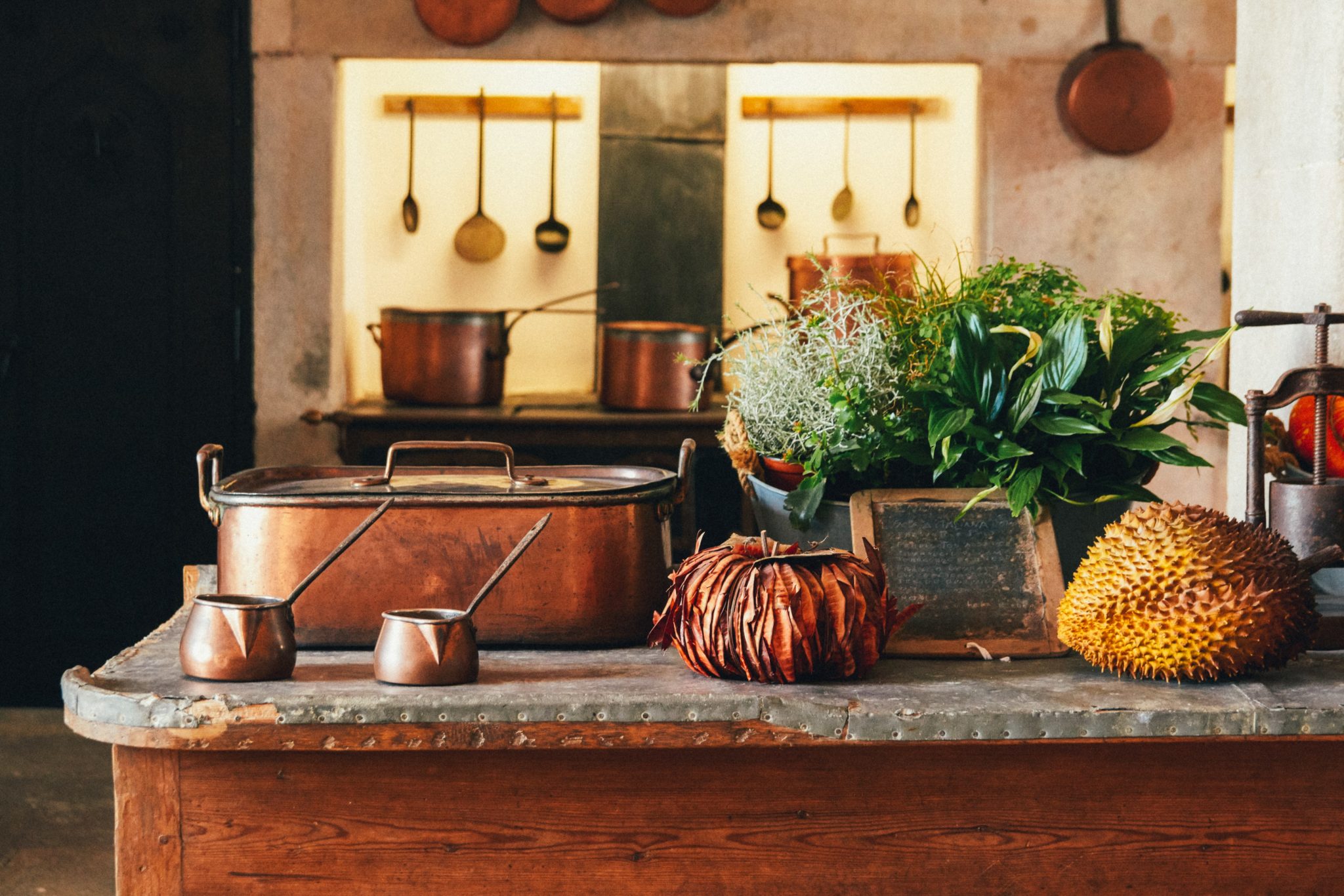



What a lovely post for a staycation that is filled with amazing dishes from different countries. So many yummy recipes to choose from.
I know right!?!?! This will fill 2 Weeks of Dinners!!
What a wonderful idea, would do veganized dishes 😉
A big thank you for including me. All the recipes included look so delicious. I am definitely trying all of them one by one. They will for sure help satisfy my wonderlust😊
Stay safe
Thanks for participating Darina. I will be trying the Souvlaki- pita from Greece!!!
Yum! I want to make the Caprese pizza. I love the salad so why not!
Let us know what you think of it and take some pics!!
Omg these dishes all look so yummy! I would love to learn how to make some of these!
Perfect!! All the recipes are linked on the post so you can learn to make all the dishes. Good luck!
All delicious and beautiful. I’m adding to our cultural cuisine travel bucket list (happening in our own kitchen these days).
Love this post so much, all so yummy tasty, hungry hungry 😛
Yeah!! My craving of Rendang Chicken got featured too, thanks!
Cheers,
SiennyLovesDrawing
Great post Michelle – I’m regretting reading it while hungry – so many delicious dishes from all around the world! Thank you for including my contribution.
I had a ‘Dholl Puri’ a little while ago, but didn’t know what it was called until I read your post, and have been trying to find it ever since! Seriously, thank you so much for sharing! I’ll be making these tonight!
Awesome!! Enjoy your virtual trip to Mauritius!
The Welsh Rarebit looks so delicious!